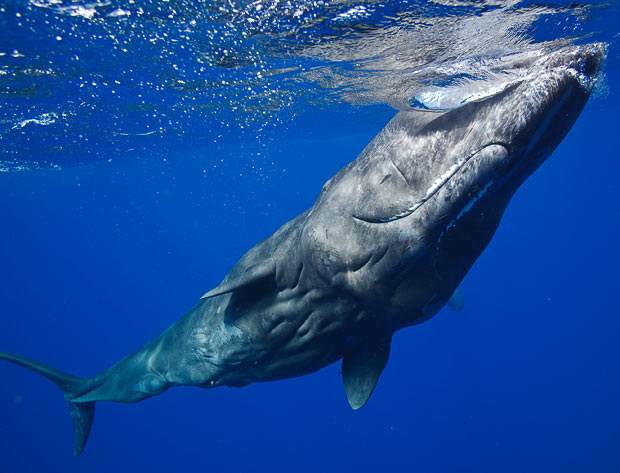Balaenoptera borealis
IUCN
LCBasic Information
Scientific classification
- name:Balaenoptera borealis
- Scientific Name:Balaenoptera borealis,Sei whale, baleen whale, northern baleen whale, great baleen whale, cod whale
- Outline:Cetacea
- Family:Mysticeti
Vital signs
- length:18.6-20m
- Weight:45T
- lifetime:Around 1974
Feature
Fast swimmers, possibly the fastest of all whales
Distribution and Habitat
Origin (sea): Angola, Argentina, Australia, Bahamas, Bermuda, Brazil, Canada, Cape Verde, Chile, Congo, Cuba, Dominica, Falkland Islands (Malvinas), Faroe Islands, French Southern Territories, Gibraltar, Greenland, Haiti, Iceland, Ireland, Japan, Kenya, North Korea, South Korea, Madagascar, Mauritania, Mexico, Morocco, Namibia, New Zealand, Northern Mariana Islands, Norway, Peru, Portugal, Reunion, Russia, St. Helena, Tristan da Cunha, St. Pierre and Miquelon, South Africa, South Georgia and South Sandwich Islands, Spain, Turks and Caicos Islands, United Kingdom, United States, Uruguay, Western Sahara.
Sei whales are oceanic whales and are not common in coastal waters. They can be found in both the northern and southern hemispheres from tropical to polar zones, but are more common in temperate zones at mid-latitudes than other baleen whales.
Appearance
The maximum length of the sei whales in the Southern Hemisphere can reach 20m, and 18.6m in the North Pacific. Females are slightly larger than males. The head length accounts for about 20%~25% of the body length. The ventral folds do not reach the navel. The North Pacific sei whales have 32~60 ventral folds. The dorsal fin is located at a distance slightly less than 2/3 of the body length. Its front edge is curved into an arch, and the rear edge is about 45° with the body, with the tip facing backwards. The flippers are pointed and small. The tail is also relatively small. The body is dark gray, with a slight blue tint from the back to the sides of the body. There are often small light scars on the body, making the body surface appear electroplated metallic. There is often a white spot in the ventral fold area. The flippers and tail are the same color or slightly lighter on the ventral side as the body. There are about 300~400 baleen plates on each side of the upper jaw. The baleen pl
Details
Sei whales are called Sei whales in foreign languages and have two subspecies.

The body shape of Sei whales is similar to that of fin whales, Bryde's whales and small Bryde's whales, and the shape of their dorsal fins is also similar. The main distinguishing feature is that the sei whale has a raised longitudinal ridge in the center of the back of the head, the fin whale has no longitudinal ridge on the back of the head, and the Bryde's whale has three longitudinal ridges on the back of the head.
The most common group of sei whales is 2 to 5. Sei whales swim fast, probably the fastest of all whales. Under normal circumstances, they do not dive deep. When the slow-moving sei whales emerge from the water, their blowholes and dorsal fins often emerge from the water at the same time. Sei whales that feed often dive and emerge at predictable time intervals, and often stay close to the surface of the water between two breaths. The height of the sei whale's spray is about 3m, which is lower than that of the fin whale. The interval between sprays is about 20 to 30 seconds, and after several sprays, they will dive for 15 minutes or more. They mate and conceive in temperate waters in winter, migrate to high-latitude waters to feed in summer, and return to warmer waters to give birth in the following winter.
In the feeding grounds, more sei whales can gather. They obtain plankton in the seawater by skimming and filter food with fine whiskers. In the North Pacific, their main food is copepods, and krill only accounts for about 10%. In the Southern Hemisphere, krill is their main food.
The male sei whales in the North Pacific reach sexual maturity at a length of about 12.8m, and the females are about 13.3m. The gestation period is about 10.5 months. They give birth in the low-latitude part of their distribution area in winter, and the newborn whales are about 4.4m long. The lactation period exceeds 6 months, and the calves are weaned in the feeding grounds in high-latitude waters when they are about 9m long. After about 6 months of anestrus, the female whales enter the estrus period in the breeding season of the following winter.
Listed in Appendix II of the Convention on the Conservation of Migratory Species of Wild Animals (CMS).
Listed in Appendix I of the Convention on International Trade in Endangered Species of Wild Fauna and Flora (CITES).
Listed in the List of National Key Protected Wildlife: National Second Class Protected Animal (effective December 10, 1988, Cetacean*Other Cetaceans),
Listed in the IUCN Red List: Endangered Species (EN), assessed in 2008.
Listed in the first level of the "List of National Key Protected Wildlife in China".
Protect wild animals and eliminate game.
Maintaining ecological balance is everyone's responsibility!








